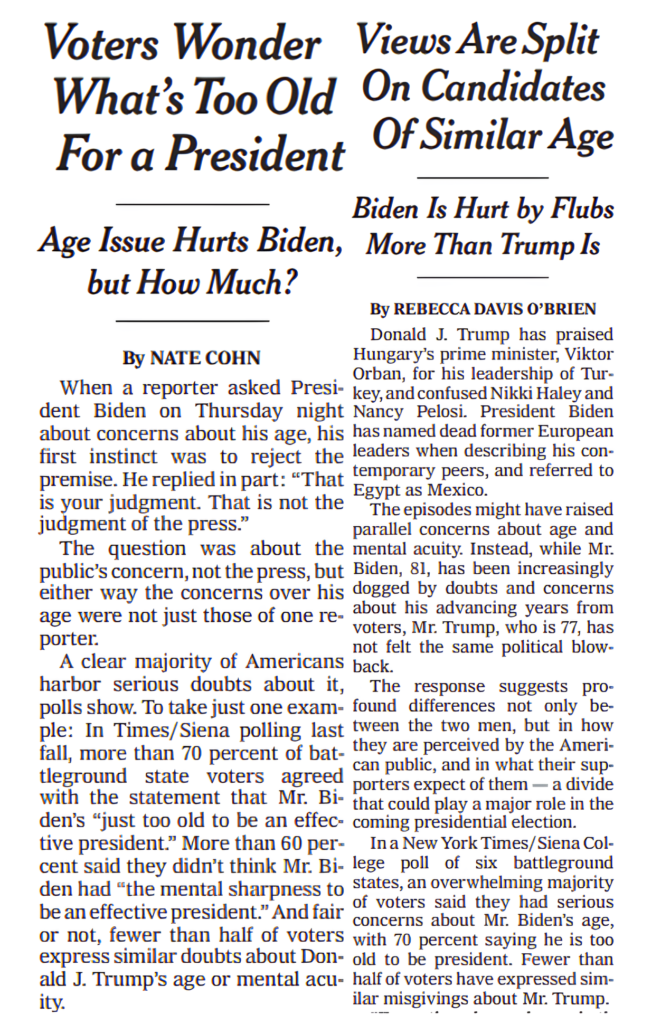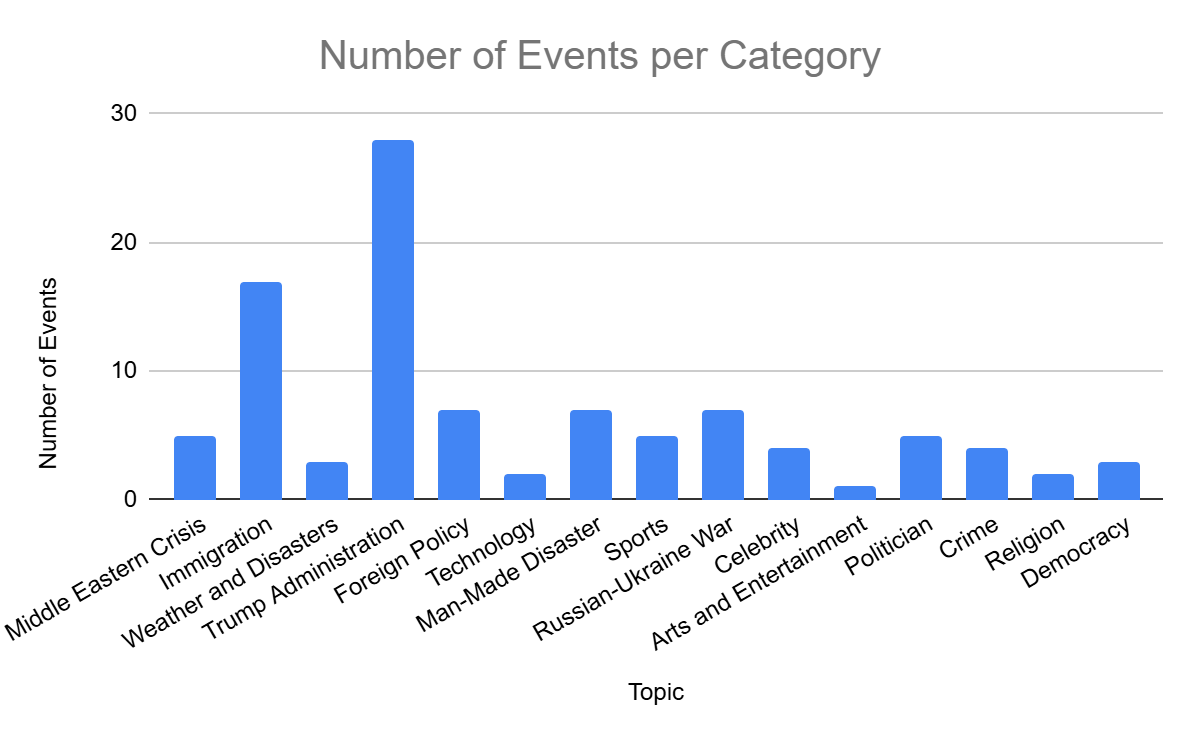Joe Biden’s (but not Donald Trump’s) age: A case study in the New York Times’ inconsistent narrative selection and framing
By David M. Rothschild, Duncan Watts, Jenny Wang
On the weekend of March 2-3, 2024, the landing page of the New York Times was dominated by coverage of their poll showing voter concern over President Biden’s age. There was a lot of concern among Democrats about the methods of the poll, especially around the low response rate and leading questions. But as a team of researchers who study both survey methods and mainstream media, we are not surprised that people are telling pollsters they are worried about Biden’s age. Why wouldn’t they? The mainstream media has been telling them to be worried about precisely this issue for months.
To illustrate, consider the most recent news storm of coverage about Biden’s age, which did not start with any incident regarding Biden’s physical or mental ability, but rather when the Republican Special Counsel, appointed by the Democratic Attorney General to investigate Biden’s document security and retention protocol, confirmed that Biden had done nothing illegal. The Times (and the rest of the mainstream media) did not seem concerned at all about Biden’s document security and retention protocol, or his exoneration. However, they were very concerned that this particular Republican lawyer (with no medical training) was concerned about Biden’s age (or, more precisely, that Biden could or would use his age as an excuse in a trial, if he were indicted for his document security and retention protocol).
Did the Times overdo its coverage of Biden’s age versus other plausible news topics of interest for Americans?
During the week that the Special Counsel’s report came out, we examined the top 20 articles on the Times’ landing page every four hours. In that time, they published 26 unique articles about Biden’s age, of which 1 of them explored the possibility that Trump’s age was of equal or more concern. This seems like a lot of articles in a short amount of time, but it’s hard to say whether or not it is excessive without some other equally relevant issue to compare it with. Helpfully, an obvious comparison arose when, on February 10, 2024, Trump announced that if he regained power he would pull the US out of NATO and even encourage Russian invasions of democratic allies if their financial commitments were not to his liking. This announcement that Trump would upend the world’s core military alignment of the last 75+ years, garnered 10 unique articles in the timeframe. The figure below charts all of these unique articles (and 1 which covers both topics) and how long they stayed in the top 20.

We believe that the choice of the Times to publish almost three times as many articles about Biden’s age as about Trump pulling the US out of NATO represents a clear example of biased coverage. In turn, this choice misinforms the NYTs millions of readers about the relative value of these topics and their underlying facts. Indeed, the 26 articles about Biden’s age are extremely light on underlying facts: nine are opinion pieces that restate facts from headline articles while many more are “news analysis” pieces (i.e., opinion pieces written by journalists) that speculate on the political consequences of people being worried about Biden’s age. Even the supposedly “hard news” articles are more reports of people being concerned than about any identifiable age-related problem in Biden’s performance as president.
Why does the Times think Biden’s age is so much more important for the American people to be thinking about relative to Trump’s age?
Trump is merely three years younger than Biden, also suffers from the occasional malapropism, and has experienced a range of health scares since his time in office. The choice of highlighting Biden’s age, while ignoring Trump’s, also implicitly misinforms readers. The Times justifies this choice by citing fall 2023 polling showing voters cared about Biden’s age more than Trump’s. The image below shows the printed front-page articles on Day 2 and Day 3 (February 9 and 10) of their news storm coverage of Biden’s age, both of which make this point. What these articles do not say, or even acknowledge the possibility of, is that the reason people are more concerned about Biden’s age than Trump’s age is the excessive media coverage of Biden’s age relative to Trump’s age. If true, then the Times is engaged in a game of circular narrative construction: first, cover an issue excessively relative to other equally or more important issues; second, conduct opinion polls and follow up reporting that offer respondents the opportunity to express concern about the excessively covered issue; third, cover the results of stage two as if they are newsworthy events that happened independently of any prior media coverage.

Does the NYT actually engage in such circular narrative construction? To check, we continued to follow the top 20 articles on the Times’ landing page every four hours for the month after the initial wave of stories concerning Biden’s age. Figure 4 yields two observations: first, the initial wave of stories died out leading to a distinct gap in coverage that lasted almost two weeks; and second, this gap ended suddenly with a second burst of coverage that lasted another week. Critically, this second burst was triggered not by some event that generated new evidence about Biden’s age affecting his performance as president, but rather the NYT’s own poll that pointedly asked respondents about the exact issue they had just spent the previous month covering relentlessly. Consistent with the circular narrative construction hypothesis, moreover, none of this second wave of articles acknowledges the existence of the first wave or the possibility that poll respondents might simply have been parroting the NYT’s own coverage back to them. Together, these trends reveal a counterintuitive finding: Although the overall TV news audience is shrinking, the partisan TV news audience is growing. This means that the audience as a whole is in the process of being “distilled” – remaining TV viewers are growing increasingly partisan, and the partisan proportion of TV news consumers is on the rise.

If all of this feels like a “but her emails” flashback, it should. To recap, in 2016 the Times published ten printed front-page articles about Democratic nominee Hillary Clinton’s document security and retention protocol in just six days between October 29 and November 3. By focusing excessively on Clinton’s document security and retention practices, The Times implicitly suggested to its readers that this one issue was more important than (a) all of Trump’s many obvious flaws combined, and (b) any policy differences between the two candidates. Although it is essentially impossible to prove causality in unique historical incidents, research suggests that mainstream media’s (exemplified by the Times) decision to make Clinton’s document security and retention practices the dominant narrative of the campaign plausibly swayed the election in Trump’s favor. Subsequently, the Times’ relative inattention to document and security issues, by Trump himself and members of his administration (including his family members), demonstrated that the issue itself was not intrinsically important or newsworthy. As with “Biden’s age,” “Hillary’s emails” was a narrative that was explicitly constructed and actively sustained by the NYT and other mainstream media at the expense of other narratives.
To conclude, there is no objective news of the day: the news of the day is whatever the editors and journalists of powerful mainstream media outlets choose it to be. Lacking a ground truth, it is hard to determine if there is a right or wrong amount of coverage of any given narrative. However, it is possible to show how individual publishers such as the New York Times push some narratives over others, sometimes to extremes that would be hard to defend in aggregate. Any one story about Biden’s age is defensible, that is, but it is harder to defend the proposition that unspecified “concerns” about his age are three times as newsworthy as a former and possibly future US presidential candidate actively encouraging Russia to invade other countries. Finally, these choices have consequences. Although the Times might claim that they devoted considerable attention to Trump’s outburst, it is hard to deny that the disproportionate coverage of Biden’s age sends a clear signal of relative importance, especially when the narrative itself contains so few details of age-related problems. In this case, we do not yet know–and we may never know–what the consequences of this signal will be for the 2024 election, but the lesson of 2016 is that the narrative very plausibly did matter. As a result, the media in general and the NYT in particular should be held accountable for the narratives they choose to promote.
June 24, 2024: We wrote this post before the Media Bias Detector was fully operational, so the day before the launch we revisit it to see what the Media Bias Detector can add to the story of this narrative.
The first thing to do is to check the coverage and tone by the publisher. By clicking on Category (Politics) => Topic (2024 Election) => SubTopic (Biden’s Age) you get this image below (link here). First, the Fox News and Breitbart lead with the most articles, followed by the New York Times. Second, similar style publications can have dramatically different quantities of articles with the New York Times having more than 2x the Washington Post. Third, the tone is extremely negative.

Clicking through some additional views we can note that the vast majority (22 of 32) of the New York Times’ coverage is classified as “News Analysis” or “Opinion”. And that lean is a bit of a mixed bag. As you can see below (or on this link), the Fox News coverage is hard pro-Republican, but the other publications are mainly mixed. What is happening is that while the topic itself is decidedly anti-Biden, the frames of the articles are generally very neutral, as the publications are generally not tying his age directly to any physical or mental lapses, or any issues with his job performance. Thus, many articles, in isolation, are technically neutral, even as the topic is designed to hurt Biden when entering into the public zeitgeist.

It is worth noting that it took us weeks to pull the data necessary for this original blog post below, but the daily updating data and platform live today on Media Bias Detector would have allowed us to update this emerging narrative in near real time.



